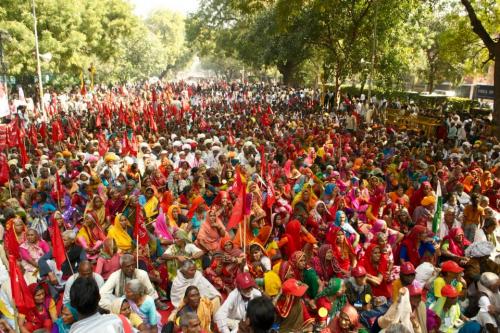
Making the case for expanding Social Security Pensions: States show the way
15 May 2015
The country has seen one of the most impressive mobilisations in recent times not by the urban middle class against corruption or farmers on the land acquisition legislation, but of a group that are perhaps most invisible- the elderly and widowed poor who have been organising under the banner of the Pension Parishad[1]. The Pension Parishad is a national campaign that has been demanding the universalisation of pensions for the unorganised sector and increasing pension amounts and has also been highlighting other shortcomings in the implementation of the National Social Assistance Pension Scheme (NSAP)[2].
The campaign represents a 100 million elderly in India who constitute 8% of the population in the country, a figure expected to go up to 12% in 2021. With an overwhelming majority of the population in the informal labour force with very little financial security and over 65% of the elderly dependent on others for their day to day maintenance[3], the case for expanding non-contributory pensions is a strong one.
When thousands of the elderly poured into Delhi and sustained a month long demonstration in the freezing winter of 2012-13 to press for their demands; the government was finally forced to respond. The government then did what the government does best when it is pushed to the wall- it made an assurance that the NSAP would be restructured and set up a task force.
The TISS-Pension Parishad Rapid Assessment[4]
To provide quick feedback into this restructuring process and an assessment of the status of NSAP implementation and innovations which can be adopted across states, the Tata Institute of Social Sciences and Pension Parishad conducted a rapid assessment of NSAP across 8 states[5], which I was a part of last summer. This was a qualitative study based on group discussions with pension beneficiaries, potential beneficiaries and interviews with elected representatives and local administration around the everyday practices of NSAP implementation. I share a brief summary of the findings here but for the full report keep a look out on the Pension Parishad website.
Not stopping at the line: States relax eligibility and top up pension amounts
Many states have gone beyond BPL criteria and numbers fixed by the Planning Commission and relaxed eligibility. States have introduced their own pension schemes where an income declaration suffices for eligibility thereby increasing the coverage target. In Rajasthan and Kerala, where the BPL criteria has been removed altogether except for very well defined exclusion criteria, exclusion was much lower. However even these states are falling far short of their own expanded targets because of insufficient funds.
Where the BPL criteria still determines eligibility two types of exclusion persisted. First, those who possessed BPL cards and met other eligibility criteria but were still not receiving pensions. Second, exclusion from the BPL list itself. This situation was particularly acute in Gujarat and Assam.
Even as the Central Government has dragged its feet for years on increasing the pension amount from the meagre amount of Rs 200 per month, states have gone ahead and topped up the central allocation. The monthly pension amounts are the highest in AP, Telangana and Haryana at Rs 1000, followed by Rs 500 in Kerala and Rajasthan, Rs 400 in Gujarat and West Bengal and Rs 250 in Assam.
The burden of proof
Two kinds of practices have been adopted across states for proactively enrolling pension beneficiaries. One is the camp mode such as holding ‘khula darbars’ in Haryana and regular gram sabhas in Andhra Pradesh. The other is using databases such as the Rural Household Survey (RHS) in West Bengal to automatically sanction pensions for members of BPL households that meet the old age pension age criteria. Despite these efforts, we found that pension applicant have to produce a multiplicity of documents such as the adhaar card, voter ID, death certificate in case the applicant is a widow, bank or post office passbook etc. to establish their identity and eligibility. This becomes the biggest barrier to access. Of the various documents, disability certificates were the hardest to get. The transaction costs to obtain these documents are high.
Apart from Kerala where facilitation centres have been set up where the applicant is assisted by ward members and tribal promoters in filling the form and getting the required documents, such institutionalised arrangements for end-to-end support in submitting pension applications did not exist in other states.
The timeline myth
Pensioners in Rajasthan, Gujarat and Kerala reported that on an average it takes six months from the time of submitting their application to receiving the pension payment even though shorter timelines of 90, 30 and 45 days have been prescribed by these three states respectively. We did not find any mechanisms for proactively informing applicants about the status of their application which makes the wait all the more harrowing. Rajasthan has made some serious efforts to improve the experience of applicants. Before payments begin, the applicant is given a letter specifying the date of application and sanctioning with a unique registration number. Applicants can then visit the Rajiv Gandhi Sewa Kendras (facilitation centres) to check the status of their application against their unique number.
A return to cash?
With the big push for direct benefit transfers through banks across the country, it was interesting to find that pensioners were happiest with the payment disbursement system in Haryana where pensions are paid in cash by the sarpanch and were perceived to be more reliable, convenient and transparent. In Rajasthan and Kerala post office money orders are the main form of disbursement and are delivered by the post man to households which are unable to come to the post office. In Andhra Pradesh, community service providers (CSPs) make pension payments. This was the only state where we found biometric payments in practice. However, all states with the exception of AP had a poor record of making pension payments on time. Payments are irregular and bunched for variable periods of time making it difficult for pensioners to keep track of which month they have received pensions for. Local administration blamed patchy fund releases from the state as the cause.
A large proportion of pensioners reported receiving their full pension amount, reiterating findings of other studies which point to low leakage in NSAP. Where there is leakage it is limited to petty bribes given to the post-man or intermediaries who help with submitting applications.
The revised NSAP guidelines issued by the Ministry of Rural Development in October 2014[6] takes many of these findings on board and seeks to address them by laying out principles such as universalisation, proactive identification, regularity and transparency. The attention of the government may have shifted to the recently announced Atal Pension Yojana, a contributory scheme is out of reach for many who lack any financial security whatsoever. Social assistance under NSAP will continue to be critical for those outside of this net and what remains to be seen is whether the government holds true on its prior commitment to improve and expand NSAP and provide more effective social security cover to the elderly, widowed and disabled in India.
[1] http://pensionparishad.org/ The campaign also raises related issues of the widowed and disabled
[2] The NSAP is a Centrally Sponsored Scheme of the Government of India which provides a small amount of financial assistance (Rs 200-500) to the elderly, widowed and disabled in the form of social pensions.
[3] NSSO rounds of data on the Condition of the Aged (2004)
[4] For other studies that highlight similar findings look at the PEEP survey results and a recently published paper by the World Bank
[5] Andhra Pradesh, Assam, Gujarat, Haryana, West Bengal, Rajasthan, Kerala, Telangana
[6] http://nsap.nic.in/Guidelines/nsap_guidelines_oct2014.pdf






